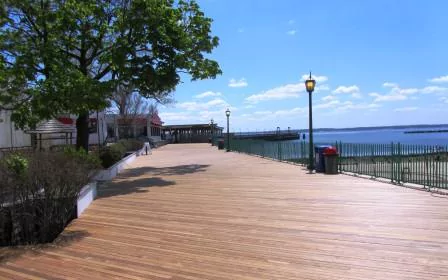
Related Posts
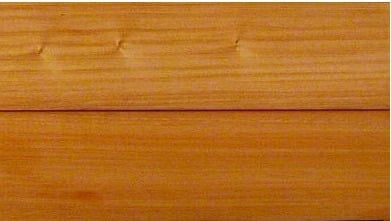
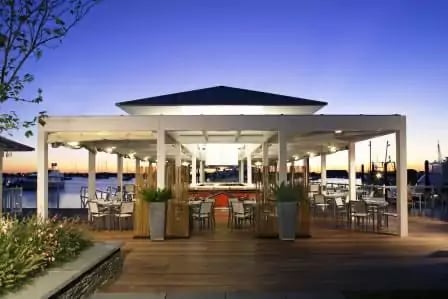

Ipe and Cumaru are two great hardwood decking material options. They are both naturally beautiful and have a lot of amazing characteristics in common. Depending on your deck project needs, either species could be a viable decking choice worth considering.
In many ways, comparing Ipe hardwood to Cumaru hardwood is a lot like comparing two great athletes – both are different but have a lot of similar traits and characteristics. Both Ipe and Cumaru wood species are very reliable, exceptionally strong, high performance, extraordinarily durable options that are far above the norm. Ultimately, it comes down to your personal preference between the two.
When you compare Cumaru decking to Ipe decking, you will see a lot of great benefits that each decking option shares.
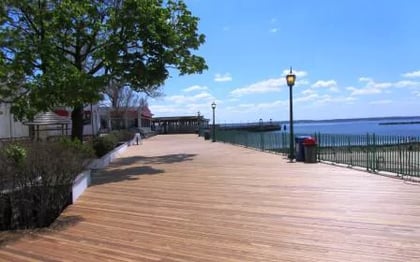
|
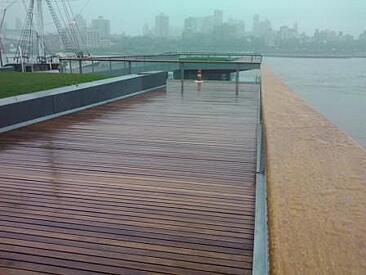 |
|
Playland Park in Rye, New York
|
Pier 15 in New York City
|
Here's a list that shows many factors each hardwood decking species has in common.
|
Grain Variations |
Lots of tropical graining, striping and exotic “figuring”. Install these different variations artfully, (like a hardwood floor) for the best look |
|
Fiber Strength |
Both species have “off the charts” bending strength |
|
Hardness |
Both Ipe and Cumaru are more than double the hardness of oak. They hold up so well for public boardwalks, just imagine how they could perform on your deck. |
|
Durability |
Both species have been rated “very durable” by the USDA Forest Products Laboratory |
|
Fire Resistance |
Both Mataverde Ipe and Cumaru hardwood decking have been tested to meet the requirements of a Class A fire rating |
|
Mataverde Warranty |
Mataverde offers a 25 year limited warranty against termites and fungal decay |
|
Life Expectancy |
40+ years or more if cleaned and maintained regularly |
|
Life-Cycle Costs |
Exceptionally low after installation, especially if the “low maintenance” option is selected |
|
Appearance/Finish |
Can be coated with UV inhibiting oil to preserve a “like new” wood appearance. |
|
Low Maintenance Option |
Allow the material to weather naturally to a silvery gray patina |
|
Workability / Installation |
Both species require carbide tools and quality craftsmanship |
As you saw in the chart above, Ipe hardwood and Cumaru hardwood have a lot of remarkable benefits in common. Both are strong, both are beautiful, but how are they different? No matter which decking option you choose, all decking material options have strengths and limitations.
 |
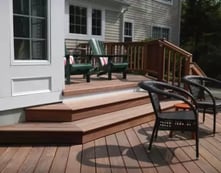
|
|
Ipe decking in a rooftop oasis
|
Cumaru decking in a backyard haven
|
The next list shows some of the basic differences between Ipe decking to Cumaru hardwood species:
|
MATAVERDE® IPE
HARDWOOD DECKING
|
MATAVERDE® CUMARU
HARDWOOD DECKING
|
|---|---|
|
Nickname: “Brazilian Walnut” |
Nickname: “Brazilian Teak” |
|
Color: Light brown to medium browns, olive browns to nearly black range of colors |
Color: Mostly medium browns to reddish brown ranges, some darker and lighter |
|
Graining: Mostly tighter, finer graining |
Graining: Predominately coarser, interlocked graining |
|
Fiber Strength: 23,360 psi |
Fiber Strength: 22,400 psi |
|
Splintering: Minimal |
Splintering: Minimal to below average. Some slight splinters may appear after wood has seasoned. If so, either foot traffic or a light sanding will remove them |
|
Slip Resistance: Ipe meets ADA slip resistance requirements |
Slip Resistance: Moderate |
|
Movement: Minimal |
Movement: Minimal to moderate |
|
Comparative Pricing: Higher |
Comparative Pricing: Moderate |
Before deciding on any decking options, it's always best to compare decking materials, to see which one works best for you and your project needs.

